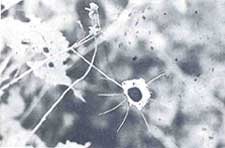Neglect robs Saurashtra park of greenery
 TUCKED away on the southern outskirts of Bhavnagar town is a dreary stretch of wilderness that once was a beautiful forest with leguminous trees and bushes spread over the rocky terrain. Creepers wove a delicate tapestry of bright flowers on the spiky branches of acacias and jujubes. Nilgai, jackal and other animals roamed freely in the forest and its small lakes were home to a variety of water birds.
TUCKED away on the southern outskirts of Bhavnagar town is a dreary stretch of wilderness that once was a beautiful forest with leguminous trees and bushes spread over the rocky terrain. Creepers wove a delicate tapestry of bright flowers on the spiky branches of acacias and jujubes. Nilgai, jackal and other animals roamed freely in the forest and its small lakes were home to a variety of water birds.
But over the years, since the Gujarat forest department assumed charge of the 100-ha wilderness called Victoria Park, it has steadily deteriorated and become the victim of callous mismanagement. Victoria Park was originally part of a larger area demarcated in 1888 for development as a private preserve by a former maharaja of Bhavnagar, Takthsinhji. He introduced blackbuck and chinkara in the area and exotic plants such as sandalwood and rudraksha. He also built a percolation tank and named it Krishnakunj. The lake was filled by water seeping in from the Gaurishankar lake in nearby Bhavnagar.
Krishnakunj and other rainfed water bodies in Victoria Park were ideal feeding and breeding spots for domestic and migratory water birds. The late Salim Ali and Lavkumar Kacher, conservation consultant to the WWF-Saurashtra branch, rated the park and its breeding sites as among the finest heronries in Asia.
Besides playing host to more than 162 bird, 31 animal and 400 plant species (including four declared protected by the Gujarat government), Victoria Park was also Bhavnagar's green lungs and part of the city's major catchment area. During the severe drought of 1910, drinking water to parts of Bhavnagar was supplied from the park's water tank.
Wasting away However, the park has withered away in the care of state forest officials. Illegal lopping and grazing are rampant and the forest department has cleared large areas of the park ostensibly to grow commercial species though a site cleared to raise a botanical garden lies bare, save for a few weeds. Also in a dilapidated state are a visitors' pavilion made of teakwood and the water tank.
Krishnakunj lake is filled with silt and requests from concerned citizens to dredge it have been ignored. The situation has worsened because silting in Gaurishankar lake has reduced water seepage into Krishnakunj. Another disturbing element -- and one that is adding to the pollution -- is a lane that runs through the park and is used as a thoroughfare. There is no check on the people streaming through or on their activities.
With natural vegetation scarce, most of the wildlife has taken refuge in the neighbouring Khokhra hills. The number of water birds in Victoria Park also has declined steadily.
The Wildlife Conservation Society of Bhavnagar has demanded that the park should be declared a nature education sanctuary, but a lethargic public and an indifferent state are unconcerned about preserving the few remaining green hectares in the state.
---Rupa Desai Abdi is a freelancer who specialises in environmental issues in Gujarat.
